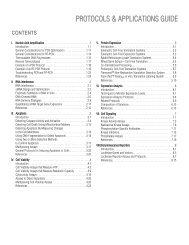Cloning Protocols and Applications Guide-A4 format - Promega
Cloning Protocols and Applications Guide-A4 format - Promega
Cloning Protocols and Applications Guide-A4 format - Promega
Create successful ePaper yourself
Turn your PDF publications into a flip-book with our unique Google optimized e-Paper software.
||||||||||||| 13<strong>Cloning</strong><br />
X-Gal (Cat.# V3941) <strong>and</strong> IPTG (Cat.# V3955). Both the<br />
pGEM®-T <strong>and</strong> pGEM®-T Easy Vectors contain numerous<br />
restriction sites within the multiple cloning region. The<br />
pGEM®-T Easy Vector multiple cloning region is flanked<br />
by recognition sites for the restriction enzymes EcoRI, BstZI<br />
<strong>and</strong> NotI, thus providing three single-enzyme digestions<br />
for release of the insert. The pGEM®-T Vector cloning<br />
region is flanked by recognition sites for the enzyme BstZI.<br />
Alternatively, a double digestion may be used to release<br />
the insert from either vector.<br />
The pGEM®-T <strong>and</strong> pGEM®-T Easy Vectors also contain the<br />
origin of replication of filamentous phage f1 for the<br />
preparation of single-str<strong>and</strong>ed DNA (ssDNA). Both<br />
pGEM®-T vector systems include a 2X Rapid Ligation<br />
Buffer for ligation of PCR products, which requires only a<br />
1-hour incubation at room temperature. The incubation<br />
period may be extended to increase the number of colonies<br />
after trans<strong>format</strong>ion. Generally, an overnight incubation<br />
at 4°C will produce the maximum number of transformants.<br />
Inserts of several kilobases have been successfully cloned<br />
into the pGEM®-T <strong>and</strong> pGEM®-T Easy Vectors<br />
(D’Avino et al. 2004). However, as the insert gets larger, the<br />
ratio of vector to insert may need to be optimized further<br />
to maximize ligation efficiency (see Ligation <strong>and</strong><br />
Trans<strong>format</strong>ion in the section "Vector:Insert Ratio").<br />
One of the disadvantages of PCR cloning into a T vector is<br />
that the insert can be cloned in either direction. Analysis<br />
of recombinant vectors by PCR or restriction enzyme<br />
digestion can be used to determine not only the success of<br />
cloning but also the insert orientation. To verify the<br />
direction of the insert, amplify recombinant plasmids using<br />
one of the gene-specific PCR primers <strong>and</strong> onel of the phage<br />
promoter primers that are present on the pGEM®-T Vector<br />
(Knoche <strong>and</strong> Kephart, 1999). The correct orientation is<br />
important for transcription or translation or both.<br />
Additional Resources for the pGEM®-T <strong>and</strong> pGEM®-T<br />
Easy Vector Systems<br />
Technical Bulletins <strong>and</strong> Manuals<br />
TM042 pGEM®-T <strong>and</strong> pGEM®-T Easy Vector<br />
Systems Technical Bulletin<br />
<strong>Promega</strong> Publications<br />
pGEM®-T Easy Vector System is an easy tool for preparing<br />
gel shift probes<br />
<strong>Cloning</strong> blunt-end Pfu DNA Polymerase-generated PCR<br />
fragments into pGEM®-T Vector Systems<br />
Stability of pGEM®-T Vectors<br />
Online Tools<br />
pGEM®-T <strong>and</strong> pGEM®-T Easy Vector sequences (select the<br />
Specifications tab)<br />
Citations<br />
Maruyama, A. et al. (2011) The novel Nrf2-interacting factor<br />
KAP1 regulates susceptibility to oxidative stress by<br />
promoting the Nrf2-mediated cytoprotective response.<br />
Biochem. J. 436, 387–97.<br />
<strong>Protocols</strong> & <strong>Applications</strong> <strong>Guide</strong><br />
www.promega.com<br />
rev. 1/12<br />
A mouse KAP1 expression plasmid was constructed by<br />
amplifying the KAP1 cDNA in three fragments from RNA<br />
isolated from NIH3T3 cells. Each of the fragments were<br />
cloned into the pGEM®-T Easy Vector. The three<br />
recombinant vectors were digested with restriction enzymes<br />
(HindIII <strong>and</strong> BamHI; BamHI; BamHI <strong>and</strong> XbaI) <strong>and</strong> the<br />
resulting fragments were ligated together <strong>and</strong> subcloned<br />
into an expression vector.<br />
PubMed Number: 21382013<br />
Aquilini, E. et al. (2010) Functional identification of the<br />
Proteus mirabilis core lipopolysaccharide biosynthesis genes<br />
J. Bacteriol. 192, 4413–24.<br />
To identify the core lipopolysaccharides (LPS) biosynthesis<br />
genes in Proteus mirabilis, 11 genes from P. mirabilis strain<br />
R110 <strong>and</strong> one from strain 51/57 were amplified from<br />
chromosomal DNA, cloned into the pGEM®-T Vector <strong>and</strong><br />
transformed into DH5α competent cells. Once the cloned<br />
genes were confirmed, each recombinant plasmid was<br />
transformed into Klebsiella pneumoniae core LPS mutants to<br />
see if any of the P. mirabilis genes complemented the<br />
mutants.<br />
PubMed Number: 20622068<br />
pTARGET Mammalian Expression Vector System<br />
The pTARGET Mammalian Expression Vector System<br />
(Cat.# A1410) is a convenient system to clone PCR products<br />
<strong>and</strong> express cloned PCR products in mammalian cells. As<br />
with the pGEM®-T <strong>and</strong> pGEM®-T Easy Vector Systems,<br />
the pTARGET Vector is supplied already linearized with<br />
single T overhangs (Figure 13.3). These single 3´ T<br />
overhangs at the insertion site greatly improve the<br />
efficiency of ligation of a PCR product into the plasmid.<br />
The pTARGET Vector also contains a modified version of<br />
the coding sequence of the α peptide of β-galactosidase,<br />
which allows recombinants to be selected using blue/white<br />
screening.<br />
Figure 13.3. pTARGET Vector circle map.<br />
The pTARGET Vector carries the human cytomegalovirus<br />
(CMV) immediate-early enhancer/promoter region to<br />
promote constitutive expression of cloned DNA inserts in<br />
mammalian cells. This vector also contains the neomycin<br />
phosphotransferase gene, a selectable marker for<br />
PROTOCOLS & APPLICATIONS GUIDE 13-4

















